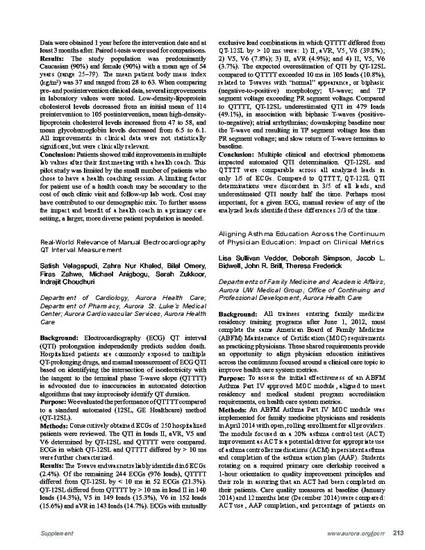
- electrocardiography,
- ECG,
- QT interval,
- sudden cardiac death
Background: Electrocardiography (ECG) QT interval (QTI) prolongation independently predicts sudden death. Hospitalized patients are commonly exposed to multiple QT-prolonging drugs, and manual measurement of ECG QTI based on identifying the intersection of isoelectricity with the tangent to the terminal phase T-wave slope (QTTTT) is advocated due to inaccuracies in automated detection algorithms that may imprecisely identify QT duration.
Purpose: We evaluated the performance of QTTTT compared to a standard automated (12SL, GE Healthcare) method (QT-12SL).
Methods: Consecutively obtained ECGs of 250 hospitalized patients were reviewed. The QTI in leads II, aVR, V5 and V6 determined by QT-12SL and QTTTT were compared. ECGs in which QT-12SL and QTTTT differed by > 10 ms were further characterized.
Results: The T-wave end was not reliably identified in 6 ECGs (2.4%). Of the remaining 244 ECGs (976 leads), QTTTT differed from QT-12SL by < 10 ms in 52 ECGs (21.3%). QT-12SL differed from QTTTT by > 10 ms in lead II in 140 leads (14.3%), V5 in 149 leads (15.3%), V6 in 152 leads (15.6%) and aVR in 143 leads (14.7%). ECGs with mutually exclusive lead combinations in which QTTTT differed from QT-12SL by > 10 ms were: 1) II, aVR, V5, V6 (39.8%); 2) V5, V6 (7.8%); 3) II, aVR (4.9%); and 4) II, V5, V6 (3.7%). The expected overestimation of QTI by QT-12SL compared to QTTTT exceeded 10 ms in 105 leads (10.8%), related to T-waves with “normal” appearance, or biphasic (negative-to-positive) morphology; U-wave; and TP segment voltage exceeding PR segment voltage. Compared to QTTTT, QT-12SL underestimated QTI in 479 leads (49.1%), in association with biphasic T-waves (positive-to-negative); atrial arrhythmias; downsloping baseline near the T-wave end resulting in TP segment voltage less than PR segment voltage; and slow return of T-wave terminus to baseline.
Conclusion: Multiple clinical and electrical phenomena impacted automated QTI determination. QT-12SL and QTTTT were comparable across all analyzed leads in only 1/5 of ECGs. Compared to QTTTT, QT-12SL QTI determinations were discordant in 3/5 of all leads, and underestimated QTI nearly half the time. Perhaps most important, for a given ECG, manual review of any of the analyzed leads identified these differences 2/3 of the time.
Available at: http://works.bepress.com/auroraelectrophysiology-fellows2/2/
